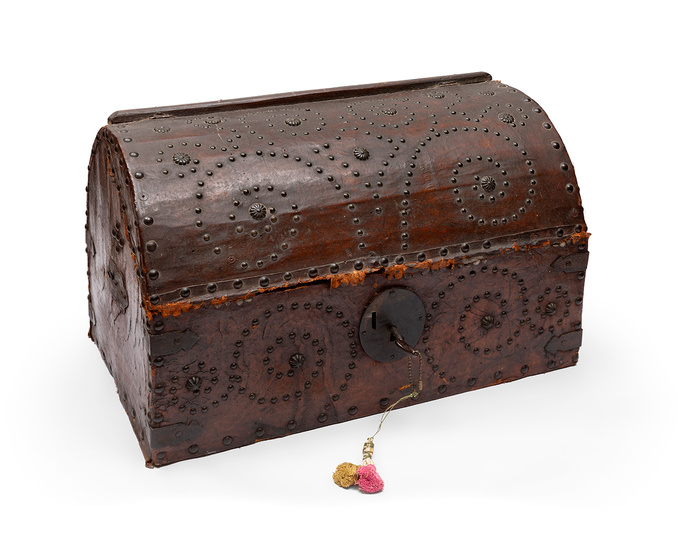Chest; Spain, late 17th - early 18th century.
Chest; Spain, late 17th - early 18th century.
Pine wood, leather and metal.
Preserves key.
Presents faults in the handles.
Measurements: 37 x 56 x 34 cm.
Spanish baroque period chest, with vaulted lid and rectangular body. Its wooden core is lined with leather, decorated with metal studding that draws on the surface rosettes and other plant-inspired representations. It has metal fittings and iron side handles. This type of furniture was very common in the Spanish territory, being frequently used to store objects of certain value such as clothes, crockery, etc. In the 17th century, in Castile, walnut chests were very common in the Valladolid area, while in the northernmost part of the country they were usually made of chestnut. As a typology, two-key chests predominate.
Spanish furniture of the 17th century is characterized by its sobriety and the birth of new typologies. Functionality is sought above decoration, moving away from the pompous solutions of previous periods. During the reign of Philip III (1598-1621) we find a style still closely linked to the sixteenth century. There is a great influence of the Escorial style, but with a greater tendency towards geometrization and simplification of forms.
COMMENTS
It preserves key. Presents faults in the handles.
View it on
Estimate
Time, Location
Auction House
Chest; Spain, late 17th - early 18th century.
Pine wood, leather and metal.
Preserves key.
Presents faults in the handles.
Measurements: 37 x 56 x 34 cm.
Spanish baroque period chest, with vaulted lid and rectangular body. Its wooden core is lined with leather, decorated with metal studding that draws on the surface rosettes and other plant-inspired representations. It has metal fittings and iron side handles. This type of furniture was very common in the Spanish territory, being frequently used to store objects of certain value such as clothes, crockery, etc. In the 17th century, in Castile, walnut chests were very common in the Valladolid area, while in the northernmost part of the country they were usually made of chestnut. As a typology, two-key chests predominate.
Spanish furniture of the 17th century is characterized by its sobriety and the birth of new typologies. Functionality is sought above decoration, moving away from the pompous solutions of previous periods. During the reign of Philip III (1598-1621) we find a style still closely linked to the sixteenth century. There is a great influence of the Escorial style, but with a greater tendency towards geometrization and simplification of forms.
COMMENTS
It preserves key. Presents faults in the handles.



